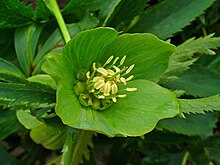Helleborus viridis
| Helleborus viridis | |
|---|---|

| |
| Scientific classification | |
| Kingdom: | Plantae |
| Clade: | Tracheophytes |
| Clade: | Angiosperms |
| Clade: | Eudicots |
| Order: | Ranunculales |
| Family: | Ranunculaceae |
| Genus: | Helleborus |
| Species: | H. viridis
|
| Binomial name | |
| Helleborus viridis | |
Helleborus viridis, commonly called green hellebore,[1][2] is a species of flowering plant in the buttercup family Ranunculaceae, native to Central and Western Europe, including southern England. All parts of the plant are poisonous.[3]
It was one of many plants first described by Linnaeus in volume one of the 1753 (tenth) edition of his Species Plantarum.[4] The Latin species epithet viridis means "green".
Two subspecies are recognised:
- Helleborus viridis subsp. viridis from Central Europe and the maritime Alps
- Helleborus viridis subsp. occidentalis from western Europe including the British Isles.[5]
Other common names recorded include bastard hellebore, bear's foot and boar's foot.[6]
Growing to around 60 cm (24 in) tall, the green hellebore is a semi-evergreen perennial plant. The flowers appear in spring (February to April).[3] They have five large green oval sepals with pointed tips, and seven to twelve much smaller petals. The roots are rhizomatous.[7] Subspecies viridis has flowers of 4–5 cm (1.6–2.0 in) diameter and leaves covered with fine hairs, while the flowers of subspecies occidentalis are smaller (3–4 cm diameter) and its leaves are smooth.[8]
The green hellebore is found in Western and Central Europe, east to eastern Austria and south to northern Italy.[5] It grows on limestone and chalk-based soils in the south of England.[3]
It has become invasive in North America, Scandinavia, the Netherlands, and northern Germany.[7]
Consumption of any part of the plant can lead to severe vomiting and seizures.[3] Its purgative properties meant that it was traditionally used as a folk remedy to treat worms in children and topically to treat lice.[3]
References[edit]
- ^ BSBI List 2007 (xls). Botanical Society of Britain and Ireland. Archived from the original (xls) on 2015-06-26. Retrieved 2014-10-17.
- ^ USDA, NRCS (n.d.). "Helleborus viridis". The PLANTS Database (plants.usda.gov). Greensboro, North Carolina: National Plant Data Team. Retrieved 19 January 2016.
- ^ a b c d e North, Pamela Mildred (1967). Poisonous plants and fungi in color. London: Blandford Press. p. 117. OCLC 955264.
- ^ Linnaeus, Carl (1753). "Tomus I". Species Plantarum (in Latin). Vol. 1. Stockholm: Laurentii Salvii. p. 558.
- ^ a b "Helleborus viridis L". Flora Europaea. Royal Botanical Garden Edinburgh. Retrieved 29 January 2015.
- ^ Wagstaff, D. Jesse (2008). International Poisonous Plants Checklist: An Evidence-Based Reference. CRC Press. p. 188. ISBN 9781420062533.
- ^ a b Moss, Charles Edward (1914). The Cambridge British Flora. Cambridge University Press. p. 108.
- ^ Servettaz, O.; Colombo, M. L.; Tomè, F. (1988). "Taxonomical investigations on Helleborus viridis s. l. (Ranunculaceae) in Northern Italy". Plant Systematics and Evolution. 160 (3–4): 181–88. doi:10.1007/BF00936045. S2CID 30745075.
External links[edit]
 Media related to Helleborus viridis at Wikimedia Commons
Media related to Helleborus viridis at Wikimedia Commons Data related to Helleborus viridis at Wikispecies
Data related to Helleborus viridis at Wikispecies
